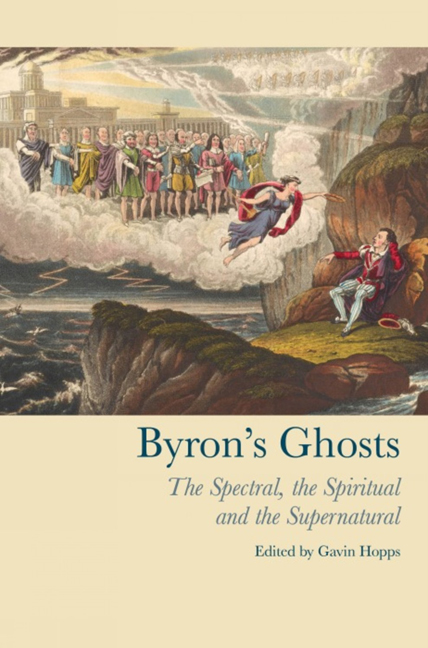Book contents
- Frontmatter
- Dedication
- Contents
- Acknowledgements
- Texts and Abbreviations
- Introduction: The Re-Enchantment of Romanticism
- Chapter 1 Determining Unknown Modes of Being: A Map of Byron's Ghosts and Spirits
- Chapter 2 Shades of Being: Byron and the Trespassing of Ontology
- Chapter 3 Byron and the Noonday Demons
- Chapter 4 Conjuration and Exorcism: Byron's Spectral Rhetoric
- Chapter 5 Byron avec Sade: Material and Spectral Violence in Childe Harold's Pilgrimage Canto IV
- Chapter 6 ‘’Twixt Life and Death’: Childe Harold's Pilgrimage, Don Juan and the Sublime
- Chapter 7 Byron, Ann Radcliffe and the Religious Implications of the Explained Supernatural in Don Juan
- Chapter 8 The Haunting of Don Juan
- Chapter 9 Being neither Here nor There: Byron and the Art of Flirtation
- Afterword: Blowing on a Dead Man's Embers: Byron's Biographical Ghosts
- Bibliography
- Notes on Contributors
- Index
Chapter 8 - The Haunting of Don Juan
- Frontmatter
- Dedication
- Contents
- Acknowledgements
- Texts and Abbreviations
- Introduction: The Re-Enchantment of Romanticism
- Chapter 1 Determining Unknown Modes of Being: A Map of Byron's Ghosts and Spirits
- Chapter 2 Shades of Being: Byron and the Trespassing of Ontology
- Chapter 3 Byron and the Noonday Demons
- Chapter 4 Conjuration and Exorcism: Byron's Spectral Rhetoric
- Chapter 5 Byron avec Sade: Material and Spectral Violence in Childe Harold's Pilgrimage Canto IV
- Chapter 6 ‘’Twixt Life and Death’: Childe Harold's Pilgrimage, Don Juan and the Sublime
- Chapter 7 Byron, Ann Radcliffe and the Religious Implications of the Explained Supernatural in Don Juan
- Chapter 8 The Haunting of Don Juan
- Chapter 9 Being neither Here nor There: Byron and the Art of Flirtation
- Afterword: Blowing on a Dead Man's Embers: Byron's Biographical Ghosts
- Bibliography
- Notes on Contributors
- Index
Summary
‘What is a ghost?’ Stephen said with tingling energy. ‘One who has faded into impalpability through death, through absence, through change of manners.’
(James Joyce, Ulysses)The mighty dead return, but they return in our colors, and speaking in our voices, at least in part, at least in moments, moments that testify to our persistence, and not to their own.
(Harold Bloom, The Anxiety of Influence)The past is never dead. it's not even past.
(William Faulkner, Requiem for a Nun)The haunting of Don Juan, a spectral visit at the heart of the last episode in Byron's unfinished mock epic, has haunted me for a long time. I first encountered this ghost story, so Gothic and yet so rational, as a graduate student. The haunting made its way into my dissertation and, years later, into ‘Don Juan’ and Regency England, where the last essay, ‘Don Juan in England’, leaves the charismatic seduced or seducer suspended in a Schlegelian hovering. Byron also left the poem's protagonist hovering, wandering between two worlds and tempted by three women, one of whom has just impersonated the spectral Black Friar and paid him a midnight call. Writing that chapter, I followed the Byronic narrator's injunction and considered Don Juan's first encounter with the Black Friar an actual haunting of some sort. But I could never totally exorcize the other possibility – that both visits might be instances of the fictively material impersonating the immaterial – an enactment of the multi-layered Platonism that it amuses Byron to represent elsewhere in his poem, for instance towards the end of Canto II, as the narrator speaks of being at a masquerade with Philosophy, ‘masqued then as a fair Venetian’, and his partner, a palpable and particular woman, simultaneously incarnates the abstraction and disguises herself as the muse imagined to embody it (II, 209–11). In the years that followed, I've been revisited, at midnight moments and others, by the shape-shifting practical and critical problems the Black Friar poses.
- Type
- Chapter
- Information
- Byron's GhostsThe Spectral, the Spiritual and the Supernatural, pp. 184 - 201Publisher: Liverpool University PressPrint publication year: 2013



